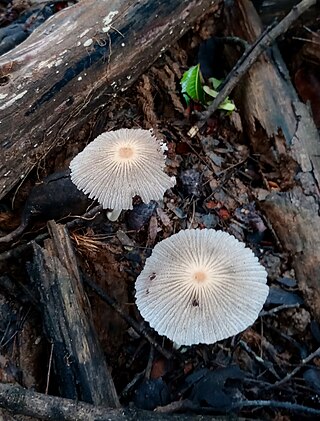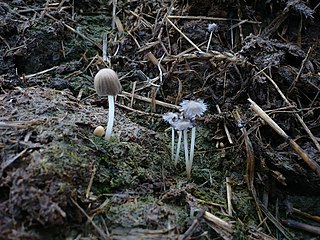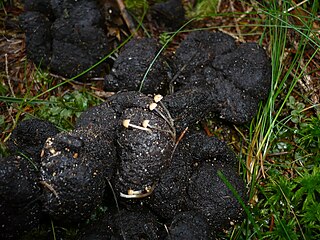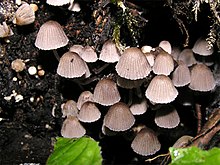
The Psathyrellaceae are a family of dark-spored agarics that generally have rather soft, fragile fruiting bodies, and are characterized by black, dark brown, rarely reddish, or even pastel-colored spore prints. About 50% of species produce fruiting bodies that dissolve into ink-like ooze when the spores are mature via autodigestion. Prior to phylogenetic research based upon DNA comparisons, most of the species that autodigested were classified as Coprinaceae, which contained all of the inky-cap mushrooms. However, the type species of Coprinus, Coprinus comatus, and a few other species, were found to be more closely related to Agaricaceae. The former genus Coprinus was split between two families, and the name "Coprinaceae" became a synonym of Agaricaceae in its 21st-century phylogenetic redefinition. Note that in the 19th and early 20th centuries the family name Agaricaceae had far broader application, while in the late 20th century it had a narrower application. The family name Psathyrellaceae is based on the former Coprinaceae subfamily name Psathyrelloideae. The type genus Psathyrella consists of species that produce fruiting bodies which do not liquify via autodigestion. Psathyrella remained a polyphyletic genus until it was split into several genera including 3 new ones in 2015. Lacrymaria is another genus that does not autodigest its fruiting bodies. It is characterized by rough basidiospores and lamellar edges that exude beads of clear liquid when in prime condition, hence the Latin reference, lacryma (tears).

Tulosesus amphithallus is a species of mushroom producing fungus in the family Psathyrellaceae.

Coprinellus aureogranulatus is a species of mushroom in the family Psathyrellaceae. It was first described as Coprinus aureogranulatus by mycologists C.B. Uljé and A. Aptroot in 1998, and later transferred to the genus Coprinellus in 2001.

Tulosesus bisporiger is a species of mushroom producing fungus in the family Psathyrellaceae.

Tulosesus ephemerus is a species of mushroom producing fungus in the family Psathyrellaceae.
Tulosesus callinus is a species of mushroom producing fungus in the family Psathyrellaceae.

Tulosesus bisporus is a species of mushroom producing fungus in the family Psathyrellaceae.
Coprinellus pyrrhanthes is a species of mushroom in the family Psathyrellaceae. First described as Coprinus pyrrhanthes by the mycologist Henri Romagnesi in 1951, it was later transferred to the genus Coprinellus in 2001.
Tulosesus plagioporus is a species of mushroom producing fungus in the family Psathyrellaceae.

Tulosesus pellucidus is a species of mushroom producing fungus in the family Psathyrellaceae.
Tulosesus hiascens is a species of mushroom producing fungus in the family Psathyrellaceae.
Coprinellus heptemerus is a species of mushroom in the family Psathyrellaceae. It was first described as Coprinus heptemerus by mycologists M. Lange and Alexander H. Smith in 1952, and later transferred to the genus Coprinellus in 2001. It is a coprophilous fungus and it is known to occur on the dung of goats and possibly on that of sheep.
Tulosesus velatopruinatus is a species of mushroom producing fungus in the family Psathyrellaceae.
Tulosesus subpurpureus is a species of mushroom producing fungus in the family Psathyrellaceae.
Tulosesus subimpatiens is a species of mushroom producing fungus in the family Psathyrellaceae.
Tulosesus subdisseminatus is a species of mushroom producing fungus in the family Psathyrellaceae.
Tulosesus sclerocystidiosus is a species of mushroom producing fungus in the family Psathyrellaceae.
Tulosesus sassii is a species of mushroom producing fungus in the family Psathyrellaceae.

Parasola auricoma is a species of agaric fungus in the family Psathyrellaceae. First described scientifically in 1886, the species is found in Europe, Japan, and North America. The mushroom was reported in February 2019 in Colombia, in the city of Bogota by the mycologist Juan Camilo Rodriguez Martinez. The small, umbrella-shaped fruit bodies (mushrooms) of the fungus grow in grass or woodchips and are short-lived, usually collapsing with age in a few hours. The caps are up to 6 cm (2.4 in) wide, initially elliptical before flattening out, and colored reddish-brown to greyish, depending on their age and hydration. They are pleated with radial grooves extending from the center to the edge of the cap. The slender, whitish stems are up to 12 cm (4.7 in) long and a few millimeters thick. Microscopically, P. auricoma is characterized by the presence of setae in its cap cuticle. This characteristic, in addition to the relatively large, ellipsoid spores can be used to distinguish it from other morphologically similar Parasola species.










